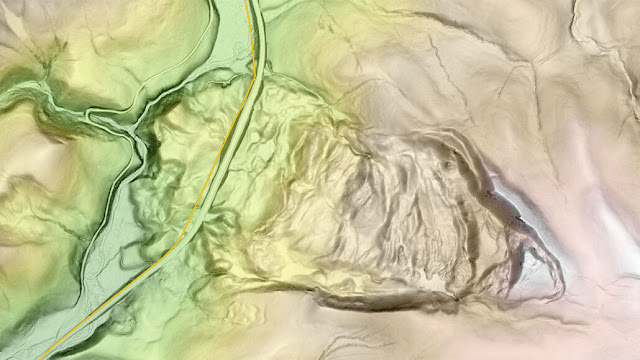Over a thousand landslides have swept through the park.
DENVER (AP) — Thanks to a laser-equipped plane, a hidden landscape riddled with landslides is coming into focus in Yellowstone National Park.
Yellowstone's first national park was studied by scientists who crisscrossed it on foot and studied aerial photographs. However, researchers now have access to a massive new digital dataset that is shedding new light on this nearly 1-million-hectare natural wonderland.
Landslides in Yellowstone are important to map because they can damage infrastructures such as roads and bridges. The millions of visitors who visit Yellowstone each year enter through just a few entrance roads, one of which was recently closed for months due to severe flooding.
A small plane flew a few hundred meters above Yellowstone's otherworldly landscape in 2020. It wasn't, however, transporting tourists seeking close-up views of the park's famous wolves or hydrothermal vents (SN: 7/21/20, SN: 1/11/21). Instead, the plane carried a downward-facing laser that fired infrared light pulses at the ground. Researchers reconstructed the precise topography of the landscape by measuring the timing of pulses that hit the ground and were reflected back toward the aircraft.
Such "light detection and ranging," or lidar, data reveal details that are frequently invisible to the naked eye. "We can see the ground surface as if there is no vegetation," says Kyra Bornong, a geoscientist at Idaho State University in Pocatello. Similar lidar observations have been used to locate pre-Columbian settlements deep within the Amazon rainforest (SN: 5/25/22).
The Yellowstone lidar data were collected as part of the 3D Elevation Program, an ongoing project led by the US Geological Survey to map the entire country with lidar.
These Yellowstone observations enabled a pair of researchers to pinpoint over 1,000 landslides within and near the park, hundreds of which had not previously been mapped, the researchers reported on October 9 at the Geological Society of America Connects 2022 meeting. The majority of these landslides occurred thousands of years ago, but some are still active.
Slip and slide
Over 1,000 landslides (outlined in yellow) were discovered during laser mapping of the Yellowstone area, the majority of which were located within the national park. This topographical map (red indicates higher elevations, blue indicates lower elevations) shows that many of the landslides are concentrated around the park's perimeter. While the majority are ancient, some are still in use.
Mapping Yellowstone’s hidden landslides
.jpg) |
| K. BORNONG AND B. CROSBY/IDAHO STATE UNIV., USGS |
Bornong and geomorphologist Ben Crosby used Yellowstone data, which can resolve details as small as one meter, to pinpoint landslides. The team looked for places where the landscape changed from relatively smooth to jumbled, indicating that soil and rocks had once been moving. "It's a pattern-recognition game," Crosby, of Idaho State University, explains. "You're looking for a contrast between the lumpy and smooth stuff."
The researchers discovered over 1,000 landslides in Yellowstone, the majority of which were located near the park's outskirts. According to Lyman Persico, a geomorphologist at Whitman College in Walla Walla, Wash., who was not involved in the research, this makes sense given the geography of Yellowstone's interior. The park is built on top of a supervolcano, and previous eruptions covered much of the park in lava (SN: 1/2/18). "You're in the middle of the Yellowstone caldera, where everything is flat," Persico explains.
However, steep terrain abounds in the national park, and infrastructure exists in many of the landslide-prone areas. The team discovered that roads had been built over landslide debris in several places. Highway 191, for example, skirts the western edge of Yellowstone.
Crosby believes there is much more to learn from this fresh look at Yellowstone. Lidar data can shed light on geologic processes such as volcanic and tectonic activity, in which Yellowstone is abundant. "It's a game changer," he says. CITATIONS K. Bornong and B. Crosby. A novel lidar-based landslide inventory of Yellowstone National Park. Geological Society of America Connects 2022 meeting, Denver, October 9, 2022. doi: 10.1130/abs/2022AM-378704. |


